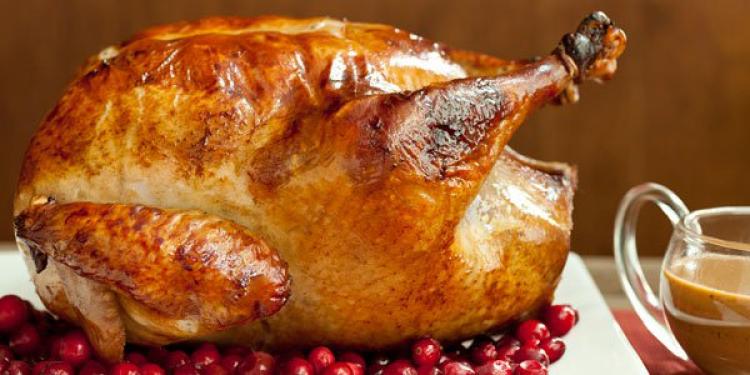You Can Bet There Will Be Turkey Despite The Taste
Posted: November 24, 2014
Updated: June 4, 2017

Food is an integral part of the Thanksgiving celebrations across the United States but some of the modern menu items weren’t part of the original meal
The eating of a large meal of seasonal foods to celebrate an event in the annual calendar has been an observance of societies since the dawn of time, and if not the dawn of time, then at least since the breakfast time of time. With so much effort going into the production of food it was natural to celebrate when the season of that labor came to an end. Any society with an agrarian base had a harvest and at its end a celebration of that harvest.
Of course the one thing you didn’t want to do right after the harvest is eat all the grain you’d just stocked up, and perhaps that gives rise to some of the traditional foods we eat at the time, with the emphasis on pumpkins and the eating of turkey that would cost too much to feed through the winter. The traditions of Thanksgiving, and indeed the meal that the holiday surrounds, stem entirely from this desire to celebrate not just a successful harvest, and by dint of that survival, but also a sudden lack of hard work about the place.
Being joyful at not having to break one’s back in the fields or threshing the crop was as ubiquitous around the world as being grateful in spring that the winter had ended and the green shoots of life had once again returned between the patches of melting snow. However it was the much more localized incidence of survival celebration that have taken the harvest festival’s traditions and kept them with us throughout our move to an industrialized society.
When the pilgrims sat down to eat that first Thanksgiving meal with the Wampangoag tribe in Plymouth back in 1621 they perhaps were unaware of the arguments that would arise as to whether they were the first or not, and that poor documentation would open the way for academic arguments on the subject, they were just celebrating not being dead and being unlikely to die in the winter to come, a season that had killed half their number just a year before.
The US Does It Bigger
In 1623 when they changed from communal to private farming a larger than usual harvest gave rise to an even bigger celebration, as a drought had been washed away in seasonally useful rains, and these were far better documented. History would have it that the first Thanksgiving meal was cooked by but four women, none of whom were invited to the party which was a male only gathering, and it included venison, fish and several varieties of fowl.
These days the meal is still of paramount importance to many, most especially those who spend all those hours preparing it for guests and relatives making the annual pilgrimage home as if trout returning upstream to spawn, and by and large it remains largely a female preserve, albeit it one slightly usurped by TV dinners and decent food delivery services that operate 365 days a year. It would be only a fool that would take to the internet betting in the US there isn’t someone doing to-your-door turkey dinners.
Food Glorious Food
- Thanksgiving Dinner a big tradition in the US
- Sports coverage remains mobile betting audience won’t be after dinner
- Turkey tastes bad and cranberries are worse
The US imports 12 million dollars worth of Turkey’s for Thanksgiving despite raising some 254 million turkeys within the US itself. This is a mammoth amount of meat and it rivals the US production of green beans, 672,370 tones, 1.1 billion pounds of pumpkins, 2.7 billion pounds of sweet potatoes and 768 million pounds of cranberries. When it comes to eating the US really does do it bigger than everyone else. Especially at Thanksgiving. Perhaps that’s why successive governments have been gambling news
from the 64,500 grocery stores across the US will help the economy.
Certainly the consuming of such large quantities of food at a specific time does have a major effect on the industries that now produce them, and once the meal is done growing numbers do then instantly go forth to shop for the run up to Christmas, in effect the meal has become now more than a celebration of something but something in of itself to be celebrated. As in the past, we give thanks for the food before us, and also for the things that are to come in the winter ahead. Albeit it more for sales and discounts than not starving to death.
Turkey Doesn’t Taste Nice
Turkey, it should be noted, tastes like cardboard. If it’s moist; like wet cardboard. Of all the fowl it is possible to consume turkey is the most tasteless with a consistency of dried out flood damaged drinks coasters and an ability to suck all the enjoyment out of anything else you eat with it. Almost acceptable in a sandwich that it is eaten by 91% of Americans on Thanksgiving is staggering. Perhaps the original idea was to save the good meat for later in the winter, or that it was just chosen for size, but whichever its still a strange choice.
Online gambling sites in the US and elsewhere would probably give you very good odds on it all being the fault of one Sarah Joespha Hale, author of the classic that is “Mary Had A Little Lamb” whose campaign to get the holiday national recognition spanned several decades and included a great many editorials on the matter that comprised of suggestions as to menu items, the blame for turkey’s now constant presence to be laid entirely at her feet. Apparently her little sheep fetish kept lamb off the menu for Thanksgiving.
20% of all cranberries are eaten at Thanksgiving despite being a taste best left forgotten. Even the cranberry industry considers them unpalatable without a such a large quantity of sugar added to them that even a chocolate manufacturer would exclaim “How much??” in shocked tones, and yet there they are. They were even recently described as being “cherries that who hate you” or in the perhaps more aptly as tasting “like what a raspberry drinks before its colonoscopy” by comedian John Oliver.
He’s not far wrong, and indeed the overall nature of the meal has changed to become a tradition made up of foods that weren’t part of the original Thanksgiving fare, and indeed those foods that were have fallen by the wayside. That turkey is now preferred to venison seems absurd, that fish are rarely seen despite being one of the few things that kept those early pilgrims alive, apparently just another of the changes that have swept along with Thanksgiving Dinner over the centuries.












